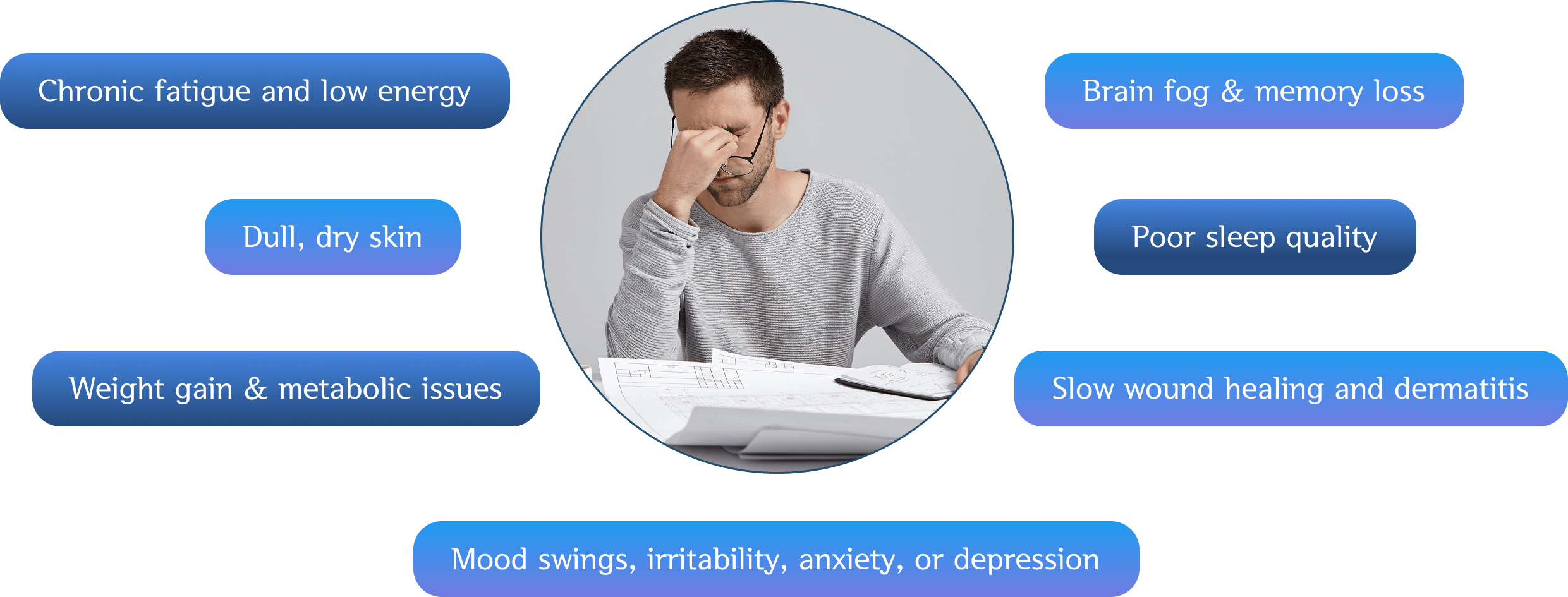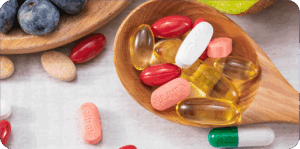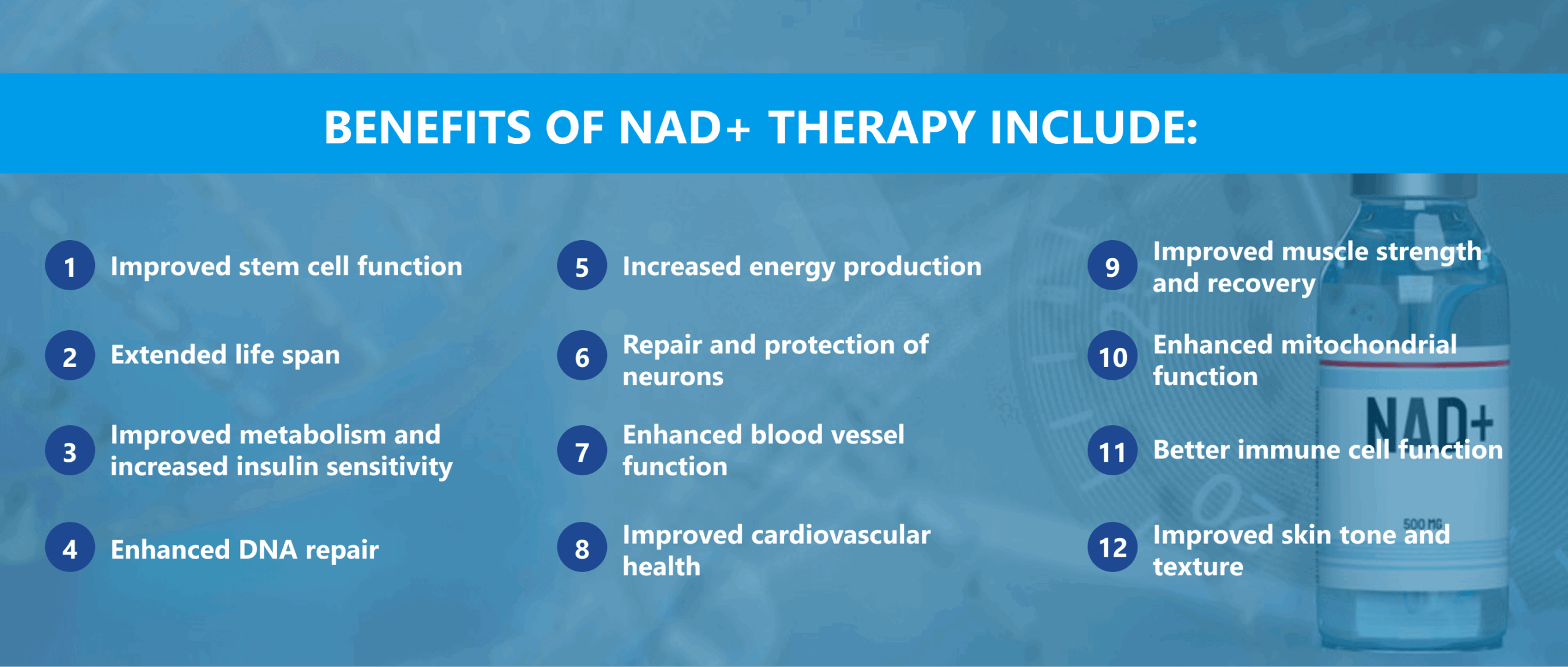 Nicotinamide adenine dinucleotide (NAD+) is a vital coenzyme found in every cell in the human body, playing a central role in numerous biochemical processes. According to research, NAD+ levels begin at about 90% of peak from birth through puberty, peaking at 100% from age 13-30, and steadily declining thereafter, falling to 50% of peak by age 50. NAD+ deficiency is more than a symptom of aging – it is a key driver of age-related decline in multiple systems, starting at the cellular level. Learn more about NAD+, its role in human health, factors that cause depletion, and actions you can take to stop NAD+ decline and reverse its symptoms.
Nicotinamide adenine dinucleotide (NAD+) is a vital coenzyme found in every cell in the human body, playing a central role in numerous biochemical processes. According to research, NAD+ levels begin at about 90% of peak from birth through puberty, peaking at 100% from age 13-30, and steadily declining thereafter, falling to 50% of peak by age 50. NAD+ deficiency is more than a symptom of aging – it is a key driver of age-related decline in multiple systems, starting at the cellular level. Learn more about NAD+, its role in human health, factors that cause depletion, and actions you can take to stop NAD+ decline and reverse its symptoms.
NAD+ and Human Health
Nicotinamide adenine dinucleotide (NAD+) is present in all known life forms, not just humans. NAD+ plays a key role in cellular biology, including energy production, DNA repair, and regulation of gene expression, metabolic functions, and aging processes. In essence, without NAD+, we would all die.
Here are some of the key roles of NAD+ in human biology:
- Mitochondrial function and energy production: Mitochondria are organelles located within the cytoplasm of cells, and responsible for cellular respiration and ATP production. NAD+ acts as a coenzyme in the mitochondria to help convert nutrients into energy.
- DNA repair and cellular maintenance
- Activation of Siruins (SIRT1–SIRT7)
- Immune support
- Protection of neurocognitive health
- Regulation of metabolic pathways
- Support of cardiovascular health
- Defence against premature aging
Your body makes NAD+ from precursor micronutrients extracted from your diet, but modern lifestyles and environmental factors can cause depletion unless you take concrete steps to supplement your diet while making better lifestyle choices.
Factors that Deplete NAD+ in Humans
To optimize NAD+ levels, you must address multiple factors that cause depletion. The good news is that many of the obstacles are within your control.
Factors that deplete NAD+ include:
- Aging and associated DNA degradation is the number one factor driving NAD+ depletion, and aging itself is a complex topic, with many moving parts. Lifestyle factors like diet, hydration, exercise and sleep can dramatically impact the rate at which you age.
- Oxidative stress causes damage to cells via reactive oxygen species (ROS) from metabolic processes and environmental toxins, damaging DNA and depleting NAD+. (e.g., pollution, smoking) cause DNA damage, increasing PARP activity and NAD+ depletion.
- Chronic systemic inflammation upregulates CD38 and PARP – enzymes involved in the immune response that consume NAD+.
- Metabolic stress caused by caloric overload from refined and processed foods, leading to NAD+ depletion.
- Obesity promotes chronic inflammation and oxidative stress, and sedentary lifestyles lead to metabolic disease that accelerate aging.
- Nutrient-poor diets, with inadequate amounts of NAD+ precursors like niacin (vitamin B3), tryptophan, nicotinamide, or nicotinamide riboside, limit the body’s ability to synthesize NAD+.
- Chronic diseases like cancer and neurodegenerative disorders increase NAD+ consumption. Insulin resistance and hyperglycemia in type 2 diabetes elevate oxidative stress and inflammation, depleting NAD+.
- Lifestyle factors like excess alcohol consumption, poor sleep habits, being sedentary, and exposure to environmental toxins all take a toll on NAD+ levels.
Supplementing with NAD+ precursors (nicotinamide riboside, NMN), getting regular exercise, spending time in nature, restricting your daily calories, and adopting a Mediterranean-style diet can all help to halt DNA damage and replenish NAD+ levels.
Signs of NAD+ Deficiency
The problem with nutrient deficiencies is that they typically have a gradual onset, and people may not recognize the signs and symptoms until deficiency becomes severe. However, in the case of NAD+, we know that the body produces less as we age, and the symptoms of deficiency are easy to recognize.
Key signs of NAD+ deficiency include:
- Chronic fatigue and low energy
- Brain fog, reduced mental sharpness and memory lapses
- Dull, dry skin
- Poor sleep quality
- Mood swings, irritability, anxiety, or depression
- Weight gain, insulin resistance, and metabolic disorders
- Slow wound healing and dermatitis

Lifestyle factors like poor diet, lack of exercise, and chronic stress can contribute to symptoms. A multifaceted approach that boosts NAD+ while adopting positive lifestyle habits can dramatically improve your health and slow the aging process.
How to Boost NAD+ Levels
NAD+ deficiency is strongly linked to aging, and most people accept its signs and symptoms as part of the aging process. But while aging is inevitable for all of us, you do not have to resign yourself to a rapid decline in health. Boosting NAD+ levels is relatively simple at any age, and lifestyle factors play a key role.
10 ways to boost NAD+ and quickly reap its health benefits:
- Exercise regularly – both aerobic exercise and resistance training boost NAD+ by increasing the demand for cellular energy, creating new mitochondria and upregulating NAMPT, an enzyme critical for NAD+ production.
- Eat foods rich in NAD+ precursors, such as: wild-caught cold water fish like salmon, tuna, and sardines; dark meat chicken and turkey; pasture-raised eggs; raw dairy; and fermented foods like kombucha, kimchi, and sauerkraut. Polyphenol-rich foods like blueberries, red grapes, and red wine also enhance NAD+ synthesis.

Exercise Regularly
Both aerobic exercise and resistance training boost NAD+ by increasing the demand for cellular energy, creating new mitochondria, and upregulating NAMPT.

Eat NAD+ Rich Foods
Wild-caught fish, dark meat poultry, eggs, raw dairy, and fermented foods provide NAD+ precursors, while polyphenol-rich foods like blueberries, grapes, and red wine enhance NAD+ synthesis.
- Try intermittent fasting by restricting calorie consumption to an abbreviated time window of 6-12 hours daily. By giving your system a break from digestion, you activate pathways that support NAD+ production.
- Reduce your total daily food consumption by prioritizing protein and eliminating simple carbs like bread, pasta, rice and potatoes. Opt for fresh fruits and vegetables and pasture-raised animal proteins. Some experts recommend one gram of protein per pound of body weight daily. If you’re overweight, shoot for one gram per pound of your goal weight.

Intermittent Fasting
Restricting eating to a 6–12 hour window gives your system a break from digestion and activates pathways that support NAD+ production.

Prioritize Protein & Cut Carbs
Reduce daily calories by prioritizing protein and eliminating simple carbs. Choose fresh fruits, vegetables, and pasture-raised animal proteins for optimal NAD+ support.
- Optimize sleep and tune into your natural circadian rhythms – NAD+ levels fluctuate throughout the day. Maintaining a consistent and high-quality sleep schedule will help promote NAD+ production.
- Reduce systemic inflammation and oxidative stress – both factors that deplete NAD+. The Mediterranean diet is an example of an anti-inflammatory diet that promotes NAD+ production and overall health.

Optimize Sleep
Maintaining a consistent, high-quality sleep schedule aligned with your circadian rhythms helps stabilize daily NAD+ levels and promotes their production.

Anti-Inflammatory Nutrition
Reducing inflammation and oxidative stress supports NAD+. The Mediterranean diet, rich in fresh produce, fish, and healthy fats, promotes optimal health and NAD+ production.
- Avoid exposure to NAD+ depleters like too much alcohol, and excessive exposure to UVA radiation. However, moderate red wine consumption and regular exposure to natural sunlight can help to increase NAD+ levels.
- Supplement with NAD+ precursors like Nicotinamide Mononucleotide (NMN), Nicotinamide Riboside (NR), or Niacin (Vitamin B3).
Smart Lifestyle Choices
Limit exposure to alcohol and excessive UV radiation. Moderate red wine and regular natural sunlight can support healthy NAD+ levels.

NAD+ Precursors
Supplement with NMN, Nicotinamide Riboside, or Niacin (Vitamin B3) to enhance your body’s ability to produce NAD+
- Try cold exposure for 30 seconds to 3 minutes per day. According to recent research, plunging briefly in cold water, taking a cold shower, or leveraging cryotherapy can trigger a cascade of reactions that enhance NAD+ production.
- Leverage the advantages of NAD+ IV therapy, to ensure optimal potency and direct delivery to the cells that need it most.

Cold Exposure
Brief cold showers, plunges, or cryotherapy sessions can trigger powerful reactions that enhance NAD+ production.

NAD+ IV Therapy
IV therapy delivers NAD+ directly to your bloodstream for maximum potency and rapid cellular support.
Benefits of NAD+ IV Infusion Therapy
NAD+ plays a critical role in all of your body’s systems, dramatically impacting your overall health. When delivered by IV infusion, NAD+ retains its full potency – something that is reduced during digestion. By introducing NAD+ directly to your blood stream, you can rest assured that your cells quickly receive the support they need for optimal biological function.
Benefits of NAD+ therapy include:
- Improved stem cell function
- Extended life span
- Improved metabolism and increased insulin sensitivity
- Enhanced DNA repair
- Increased energy production
- Repair and protection of neurons
- Enhanced blood vessel function
- Improved cardiovascular health
- Improved muscle strength and recovery
- Enhanced mitochondrial function
- Better immune cell function
- Improved skin tone and texture

Boost Health and Longevity with NAD+ IV Therapy in NYC
Urban living has its perks, but the pace and constant stimulus of city life can wreak havoc with your health. Limited access to fresh unprocessed food, and toxins in air, food and water wage a never-ending war with your immune system while depleting you of essential nutrients like NAD+.
At Invita Wellness NYC, we offer a broad selection of nutrient IV cocktails and boosters to optimize your health and promote longevity. Other wellness solutions include cryotherapy, hyperbaric oxygen therapy, and even hangover therapy, to keep you looking and feeling your best at any age. Contact Invita Wellness today, and put the brakes on aging with NAD + IV therapy, for enhanced longevity and an abundant quality of life.
Boost Health and Longevity with NAD+ IV
contact InVita Wellness today
Book Now
456 Broadway 2 Floor, New York, NY 10013, USA
Resources
Conlon, Nichola J. “The role of NAD+ in regenerative medicine.” Plastic and Reconstructive Surgery 150 (2022): 41S-48S.
The role of NAD+ in regenerative medicine
Grazioso, Tatiana P., et al. “Cold exposure reinstates NAD+ levels and attenuates hepatocellular carcinoma.” Cell Stress 8 (2024): 125.
[HTML] nih.gov
McReynolds, Melanie R., Karthikeyani Chellappa, and Joseph A. Baur. “Age-related NAD+ decline.” Experimental gerontology 134 (2020): 110888.
[PDF] nih.gov